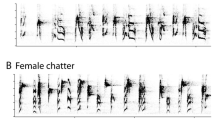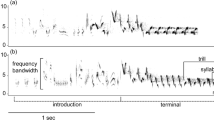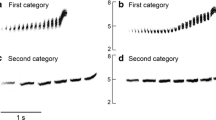Summary
Captive female song sparrows (Melospiza melodia), after treatment with estradiol, perform copulation solicitation displays when presented with songs of conspecific males. Females respond more strongly to eight song types than to four, and to sixteen song types than to eight. These results are consistent with the hypothesis that female song sparrows prefer large repertoires, rather than preferring normal or natural repertoire sizes (5 to 13 song types).
The results with captive females might be taken to imply that females in the field prefer as mates those males with the largest repertoire sizes. This hypothesis was tested by observing pairing in a field population. In each of 2 years, there was no significant correlation between male repertoire size and date of initial pair formation. Furthermore, there was no correlation between repertoire size and the speed with which a second mate was acquired after removal of the first. It is concluded that repertoire size does not have an important influence on female choice of mates in song sparrows.
Similar content being viewed by others
References
Catchpole CK (1980) Sexual selection and the evolution of complex songs among European warblers of the genus Acrocephalus. Behaviour 74:149–166
Darwin C (1871) The descent of man, and selection in relation to sex. Murray, London
Falconer DS (1960) Introduction to quantitative genetics, Ronald Press, New York
Howard RD (1974) The influence of sexual selection and interspecific competition on mockingbird song (Mimus polyglottos). Evolution 28:428–438
Knapton RW, Krebs JR (1974) Settlement patterns, territory size, and breeding density in the song sparrow (Melospiza melodia). Can J Zool 52:1414–1420
Krebs JR, Ashcroft R, Webber MI (1978) Song repertoires and territory defence. Nature 271:539–542
Kroodsma DE (1976) Reproductive development in a female songbird: differential stimulation by quality of male song. Science 192:574–575
Nice MM (1943) Studies in the life history of the song sparrow. II. The behavior of the song sparrow and other passerines. Trans Linn Soc NY 6:1–328
Searcy WA (1982) The evolutionary effects of mate selection. Annu Rev Ecol Syst 13:57–85
Searcy WA, Marler P (1981) A test for responsiveness to song structure and programming in female sparrows. Science 213:926–928
Searcy WA, Marler P (in press) Interspecific differences in the response of female birds to song repertoires. Z Tierpsychol
Searcy WA, Marler P, Peters SS (1981) Species song discrimination in adult female song and swamp sparrows. Anim Behav 29:997–1003
Walkinshaw LH (1968) Eastern field sparrow. US Natl Mus Bull 237:1217–1235
Yasukawa K (1981) Song repertoires in the red-winged blackbird: a test of the Beau Geste hypothesis. Anim Behav 29:114–125
Yasukawa K, Blank JL, Patterson CB (1980) Song repertoires and sexual selection in the red-winged blackbird. Behav Ecol Sociobiol 7:233–238
Author information
Authors and Affiliations
Rights and permissions
About this article
Cite this article
Searcy, W.A. Song repertoire size and female preferences in song sparrows. Behav Ecol Sociobiol 14, 281–286 (1984). https://doi.org/10.1007/BF00299499
Received:
Accepted:
Issue Date:
DOI: https://doi.org/10.1007/BF00299499




